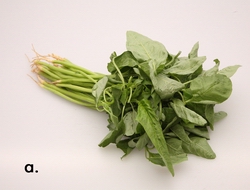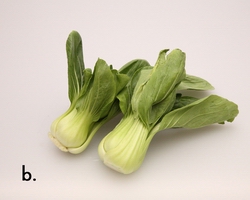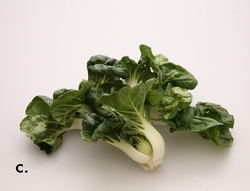
Food Safety Focus (49th Issue, August 2010) – Incident in Focus
Nitrate and Nitrite in Vegetables and Infant Feeding
Reported by Ms Melva CHEN, Scientific Officer
Risk Assessment Section, Centre for Food Safety
Nitrate occurs naturally in the environment and plants. Nitrate in vegetables can be converted to nitrite by bacteria or enzyme actions. The resulted nitrite can cause the rare blue baby syndrome. This article highlights the findings and recommendations of our study on nitrates and nitrites in vegetables.
Local Cases of Blue Baby Syndrome
In Hong Kong, two infants, eight and six months old, were reported suffering from blue baby syndrome after consuming homemade congee mixed with Chinese spinach and petiole Chinese cabbage in 2008 and 2009 respectively. Both babies were subsequently discharged after treatment. The syndrome, also called methaemoglobinaemia, occurs when the haemoglobin is unable to carry oxygen to body tissues. The patients will have their skin and lips turned blue. Infants are more susceptible to it because of the immaturity of the digestive and methaemoglobin reductase systems.
Certain Leafy Vegetables Contain Higher Nitrates
In the study, we found all 73 fresh samples of vegetables tested contained variable levels of nitrates while the nitrite levels were generally very low or negligible. Three types of leafy vegetables, namely Chinese spinach, Shanghai cabbage and petiole Chinese cabbage, contained highest levels of nitrate at a mean concentration exceeding 3 500 mg/kg. Brassica (e.g. broccoli, cauliflower), legume (e.g. snow pea), and fruiting vegetables (e.g. tomato, hairy gourd, sweet corn), root and tuber (e.g. carrot and potato), stalk and stem vegetables (e.g. asparagus, mung bean sprout) were relatively low in nitrate (mean concentration less than 1 000 mg/kg). On the whole, the nitrate and nitrite levels in vegetables were unlikely to pose immediate health risk to general population. Details can be found in the study report.
 |
 |
 |
| Examples of vegetables with high nitrate levels: Chinese spinach (a); Shanghai cabbage (b); Petiole Chinese cabbage (c). |
Handling of Vegetables Affects Nitrate and Nitrite Levels
For nitrates already exist in the vegetables, we can reduce the level by washing and peeling. Nitrate is soluble in water and thus washing and blanching of vegetables can reduce nitrate levels. Nitrate content was found to decrease significantly after peeling of vegetables such as potato. Our study also showed that the nitrate concentrations in Chinese flowering cabbage, Chinese spinach and celery reduced by 12% to 31% when they were blanched for one to three minutes.
On the other hand, we can take some measures to prevent accumulation of nitrites from the existing nitrates. Nitrite in vegetables is formed as a result of bacterial or enzyme (nitrate reductase) actions. When the fresh vegetables are pureed, the broken vegetable cells will release the enzyme for nitrite formation. Cooking can destroy the enzyme activity. However, any subsequent bacteria contamination can also result in nitrite accumulation. Nitrite accumulation is inhibited under frozen storage (at or below -18oC) but not in the usual refrigerators (about 4oC). For commercially processed infant food, the sterilization treatments necessary for canning can effectively destroy nitrite-forming microorganisms. However, once the container is opened, it is still subject to bacterial contamination if the food is not handled and stored properly.
Key Points to Note
-
Nitrates and nitrites in local vegetables are unlikely to pose immediate health risk to the population.
-
Proper handling and storage of vegetables can reduce nitrate and nitrite intake.
-
Vegetables are essential for health and different types of vegetables including leafy vegetables should be given to infants in rotation.
Vegetables in Infant Feeding
Vegetables contain dietary fibres and other nutrients essential for health. For infants, World Health Organization recommends exclusive breastfeeding for those up to six months of age. When complementary foods are introduced, the usual quantity of intake for babies of 6-12 months old is around two to four tablespoons per day. Different types of vegetables including leafy vegetables should be given to infants in rotation to maintain balanced nutrition.
Advice for the Preparation of Vegetable-containing Foods for Infants
- Prepare carefully
- Wash and peel vegetables (e.g. potato, carrot, etc).
- When chopping or mashing is required, do so shortly before cooking.
- Blanch high-nitrate vegetables in boiling water for one to three minutes and discard the cooking water before consumption.
- Store properly
- Vegetable congee and puree prepared for infants should be consumed immediately and preferably not be stored at all.
- If storage cannot be avoided, keep only for the next meal (less 12 hours) and in a refrigerator (below 4oC).
- If storage for more than 12 hours is needed, the food should be kept in freezer (at or below -18oC).
- Store the fresh leafy vegetables in refrigerator if they are not cooked immediately.
- Eat it right away
- It is most desirable to prepare the infant food immediately before consumption.
- Cooked food taken out from the refrigerator or freezer should be reheated right away by boiling thoroughly for one minute and consumed immediately.
Further Information
- "Message to Healthcare Colleagues on Nitrate/Nitrite in Vegetables and Methaemoglobinaemia in Infants" jointly developed by the CFS and Department of Health.
- "Nitrate in Food" published in the 25th Issue of Food Safety Focus in August 2008.

